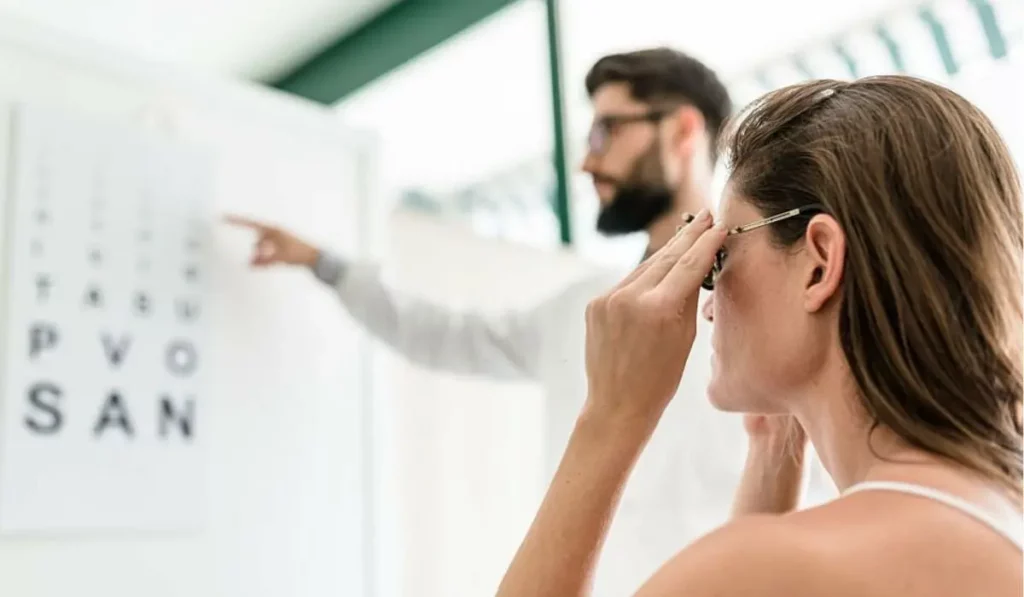Imagine your world as if your eyesight were like looking through a forever lens that was distorted. The lines that would have been straight appear crooked; all are blurred. Here comes a guide to understanding astigmatism, a common eye condition that touches millions of people globally. This blog will delve into what astigmatism is, the causes of this vision problem, and the role glasses can play in helping individuals see the world clearly.
What Is Astigmatism?
Astigmatism is one of the most common vision problems where the cornea or lens of the eye’s shape is irregular.

The cornea or lens may resemble a rugby ball or an oval-shaped ball instead of being perfectly round like a basketball. The uneven shape causes the light to be bent (refracted) unevenly, leading to distorted and blurred vision.
Causes Of Astigmatism
There are two types of astigmatism:
Corneal Astigmatism: This astigmatism is created when an irregular shape appears in the cornea, the clear front surface of the eye. Causes of such a condition could include genetics, eye injuries, or eye diseases.
Lenticular astigmatism: This astigmatism is created when the lens inside the eye is misshaped. These include aging or certain medical conditions.
Astigmatism can also be classified as regular or irregular:
Regular astigmatism: This type has the cornea or lens curved uniformly in one direction; thus, the light is refracted unevenly, in a specific pattern.
Irregular astigmatism: This kind occurs when the conical cornea or irregular curvature does not follow a specific pattern. Such vision loss is usually caused by eye injuries or certain eye surgeries.
Symptoms Of Astigmatism
The symptoms of astigmatism can vary in severity and may include:
How Is Astigmatism Diagnosed?
If you have any of these symptoms, it is essential to see an optometrist or an ophthalmologist. They will perform a series of tests to diagnose astigmatism, including:
Visual Acuity Test:
This involves viewing a series of letters from an eye chart and determining the distance at which you can see the letters.
Keratometry:
This test measures the curvature of the cornea and detects the presence and extent of astigmatism.
Refraction Test:
This is done with the use of a phoropter to help determine your visual correction needs. The eye care specialist can measure the degree and axis of astigmatism through this test.
Corneal Topography:
The high-tech imaging technology generates a detailed image of the cornea’s shape and enables the detection of astigmatism and its specific features.
How Glasses Can Correct Astigmatism?
The easiest and most effective way to correct astigmatism is by wearing a pair of spectacles after being diagnosed. They are specific glasses that take into account the distortion of the cornea or lens and aim the light properly at the retina. Here’s how they work:
Cylindrical Lenses:
Unlike ordinary eyeglasses with spherical lenses intended for nearsightedness and farsightedness, glasses for astigmatism employ cylindrical lenses. Astigmatic lenses are designed so that they have different powers in different meridians in order to counteract the uneven bending of light.
Axis Measurement:
An optometrist or ophthalmologist will measure the axis (angle) at which your astigmatism is most pronounced to create glasses that correct for astigmatism. This information helps to align the cylindrical correction right in your glasses.
Customized Prescription:
For astigmatism, a prescription will be prepared to fit your glasses. The prescription shall include spherical power, cylinder power, and axis measurements. Following the exact prescription can help adjust the light coming into your eyes and thus give you a clearer view.
Advantages Of Fixing Astigmatism With Glasses
Wearing glasses to correct astigmatism offers several benefits:
◾️ Improved Clarity
Wearing glasses can improve your vision clarity immensely, minimizing blurriness and distortion.
◾️ Reduced Eyestrain
Astigmatism may cause eye strain or discomfort. These symptoms can be alleviated by correcting them with glasses, and thus reading, working, and driving become less exhausting.
◾️ Headache Relief
In fact, many individuals with uncorrected astigmatism frequently suffer from headaches relieved by wearing correctly prescribed glasses.
◾️ Enhanced Night Vision
Individuals with astigmatism often suffer from glare and halos at night while driving; that is why they are advised to wear glasses.
◾️ Better Quality of Life
Good vision is crucial because it means that one can enjoy activities without any hindrance from poor sight.
Conclusion
If you have astigmatism, it is quite a common sight problem that can affect daily living, but it’s very manageable with the appropriate measures. The condition can be cured by wearing glasses that have been personalized to your specific prescription. For instance, if you are experiencing symptoms such as blurred vision, it is necessary to make an appointment with a specialist in eye care.
With the perfect prescription glasses, you could bring your world back to life, seeing all its beauty and comfort.

